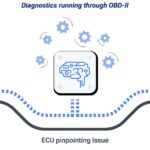Do you ever wonder what’s really going on under the hood of your car? Modern vehicles are complex machines, constantly monitoring themselves and storing a wealth of data. Obd2 Scanner Software is your key to unlocking this information, transforming your smartphone or tablet into a powerful diagnostic tool. Imagine being able to check your car’s health in real-time, understand those mysterious dashboard lights, and even track your vehicle’s performance, all from the palm of your hand. This is the power of OBD2 scanner software.
OBD2, or On-Board Diagnostics II, is a standardized system that has been mandatory in most cars manufactured after 1996. It’s designed to monitor various vehicle systems, from engine performance to emissions, and report any issues through diagnostic trouble codes (DTCs). OBD2 scanner software, when paired with a compatible OBD2 adapter, allows you to access this data and much more. Think of it as a translator, converting the complex language of your car’s computer into information you can easily understand.
One of the core functions of OBD2 scanner software is reading and clearing fault codes. When your car detects a problem, it often illuminates the “check engine” light and stores a DTC. OBD2 scanner software can retrieve these codes, providing descriptions to help you understand the issue. Many apps also offer the ability to reset these codes, which can be useful after performing repairs. Beyond basic code reading, advanced OBD2 software allows for real-time monitoring of a vast array of sensors within your vehicle. You can customize dashboards to display the gauges and charts that are most important to you, whether it’s engine temperature, RPM, speed, or fuel efficiency. For car enthusiasts and those who like to tinker, some OBD2 scanner software even supports extended PIDs (Parameter IDs). These are manufacturer-specific codes that unlock access to even more detailed data, often hidden from standard OBD2 readers, providing insights that go far beyond basic diagnostics.
Furthermore, OBD2 scanner software can be invaluable for vehicle maintenance and performance analysis. Features like Mode 06 testing allow you to view ECU self-monitoring results, helping you identify potential problems before they become serious and costly repairs. Emission readiness checks are another useful function, ensuring your car is ready to pass emissions tests, saving you time and hassle. For those interested in performance, features like acceleration timers (0-60 mph, etc.) and trip computers that track fuel consumption turn your OBD2 software into a powerful performance monitoring tool. Some advanced software even offers features like Head-Up Display (HUD) modes for safer driving and coding capabilities for certain car brands, allowing customization of vehicle settings.
To utilize OBD2 scanner software, you’ll need an OBD2 adapter that plugs into your car’s diagnostic port, typically located under the dashboard. These adapters connect wirelessly to your smartphone or tablet via Bluetooth or Wi-Fi. While there are many affordable adapters available, it’s wise to choose reputable brands to ensure reliable connection and accurate data. Be cautious of extremely cheap clones, as they can sometimes be unreliable or even cause communication issues with your vehicle’s computer. Recommended adapter brands often include Kiwi 3, Viecar, V-Gate, Carista, LELink, and Veepeak.
In conclusion, OBD2 scanner software offers an incredible range of capabilities for car owners, from basic diagnostics and fault code reading to advanced performance monitoring and vehicle customization. By empowering you to understand your car’s data, it can save you money on unnecessary repairs, help you maintain your vehicle proactively, and provide a deeper connection to your driving experience. Exploring the world of OBD2 scanner software is a smart move for any car owner looking to take control of their vehicle’s health and performance.
